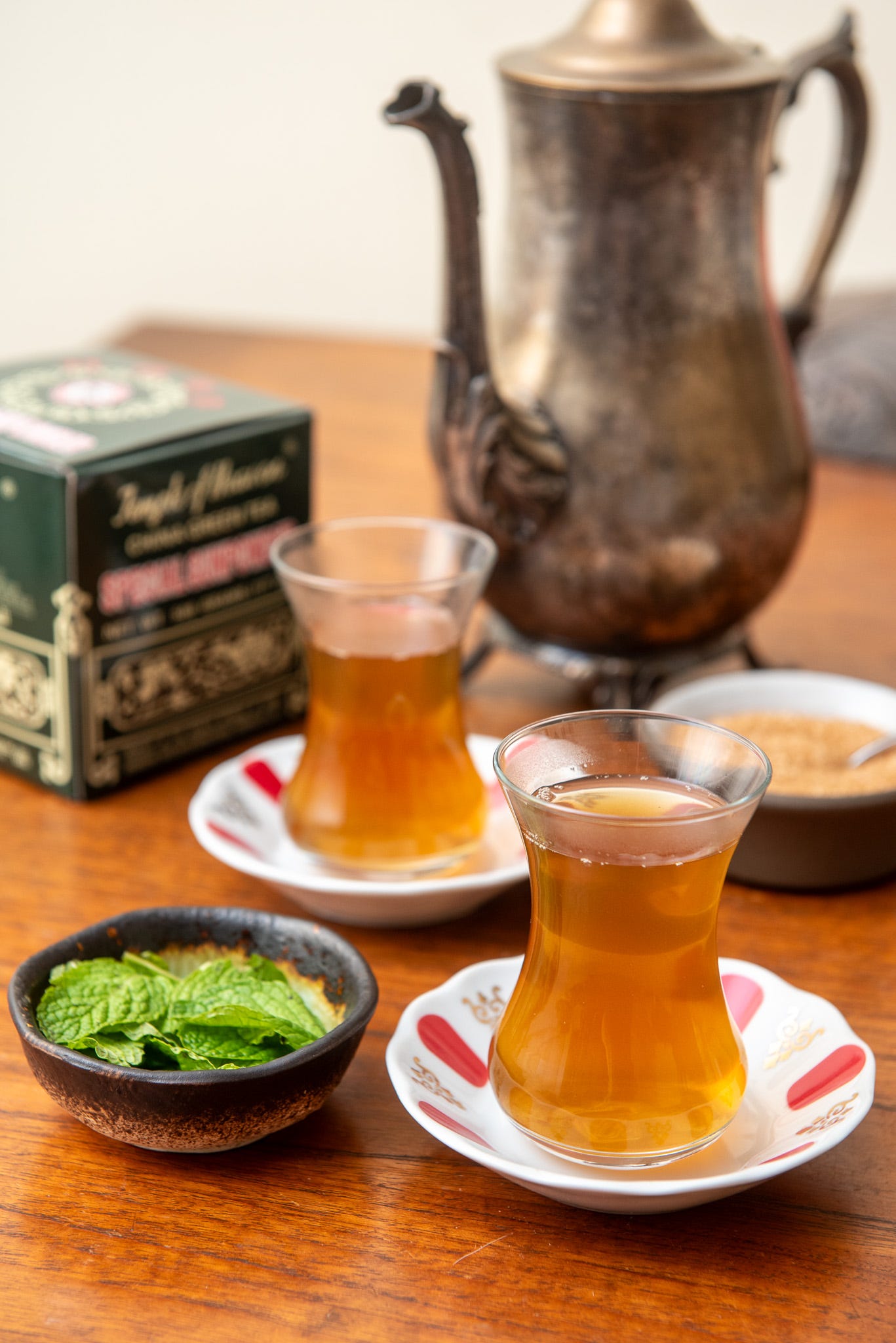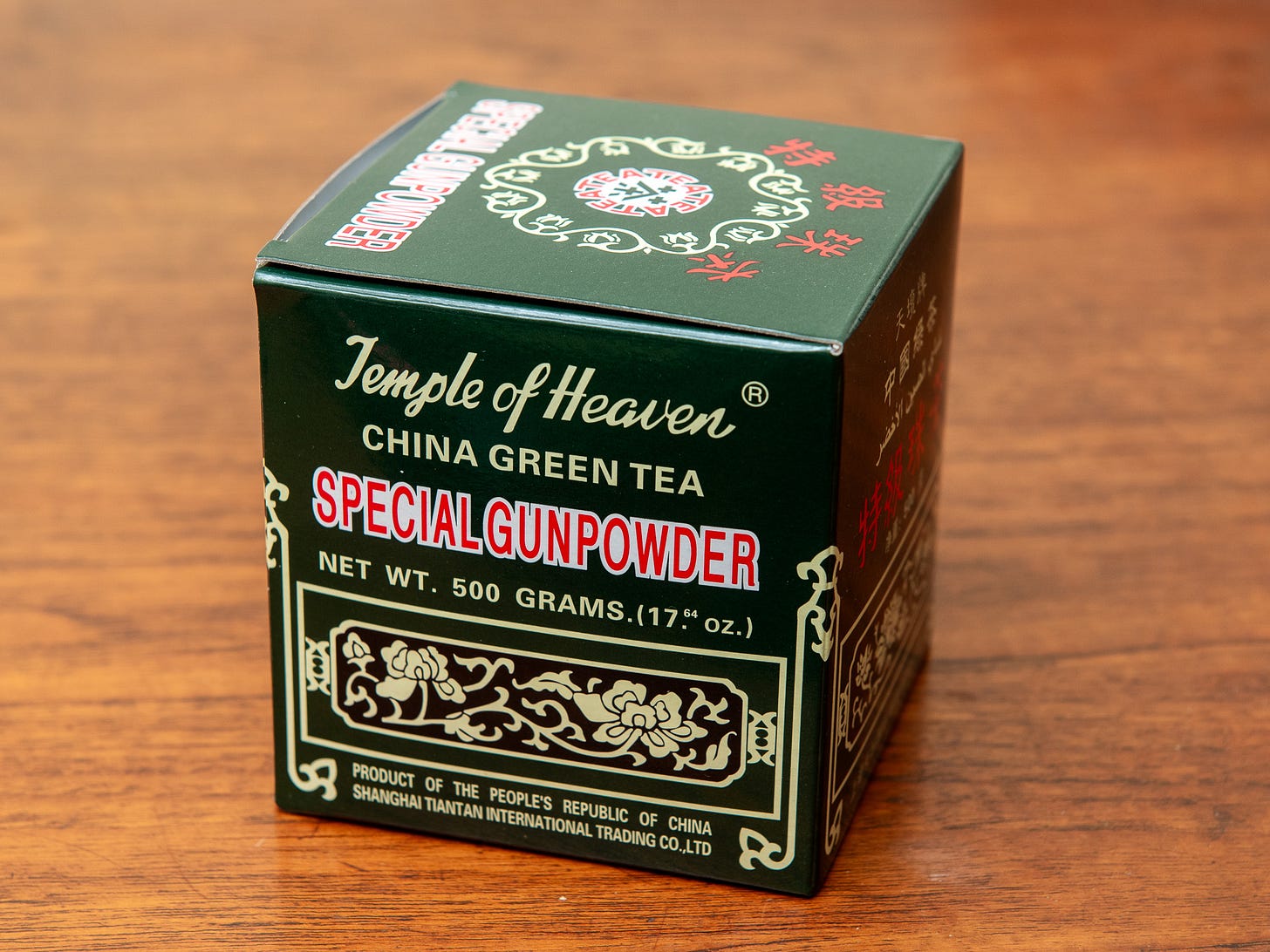The glories of gunpowder
An appreciation for an everyday brew, straight from the temple of heaven.
Prepare for blastoff
The tea: Temple of Heaven gunpowder green tea, sold all over. $5.99 for 500 grams at my local Chinese grocery.
Goofy right wing coffee company CEOs wish they had a tea blend with tasting notes of gun. Tea drinkers are luckier for we have zhu cha, or pearl tea, which likely earned the name “gunpowder” when a British trader in the 1800s noticed the rolled leaves’ similarity to blasting pellets. This low cost, rough and rowdy green tea is alleged to predate the 9th century invention of gunpowder by a couple hundred years during China’s Tang dynasty. It took off globally during the Qing Dynasty (1636 to 1912) as China increased tea exports to the West. Gunpowder’s rolled leaves packed compactly in crates and withstood the rigors of ocean freight better than other styles, which made the tea a popular choice in Britain and eventually North Africa. To this day, many people’s first cup of tea is poured from a pot of gunpowder.
As Chinese imports to the United States are about to become more scarce—online sellers Yunnan Sourcing and White2tea recently announced they’re pausing orders to the US due to tariffs—I figured it was a good time to talk about this ubiquitous, dirt cheap staple of Chinese and North African groceries. I haven’t brewed gunpowder in years, but there was a time when this specific green cube opened my eyes to what real tea could taste like. I owe a lot to gunpowder and similar supermarket teas and I know other tea people who could say the same. So during a routine grocery trip I picked up a fresh box of Temple of Heaven to see how my East Coast Marxist effete softboy palate would respond to a fresh cup.
The source: Shanghai Tiantan International Trading Company’s “Temple of Heaven” brand is the most recognizable and popular label associated with this tea. It’s not the worst quality tea you can buy, but it’s close. High grades of gunpowder can be spotted by small, evenly sized pellets of tightly rolled leaves. They should look shiny like polished clay. My box has loose squiggles of all sizes, lots of stems, and a dull industrial aroma. The form factor, though, is excellent. The box design is begging for a streetwear fashion collaboration. I love the cube. I love that centuries later, this tea remains optimized for the logistics of transport and shelf space. I love that the only packaging is a cardboard box and a basic paper liner. I admire that this marvel of mass production notes a production date (July 2023) while most elite supermarket brands never bother. Enter Temple of Heaven into the packaging design hall of fame.
To brew: Woof, this is rough! I remember the smoky charred notes developed during processing but not the cardboardy character that crinkles my stomach. There are soft floral and nutty flavors hiding beneath blasts of bitterness; the weaker you brew the tea, the more those subtleties peek through. However many of gunpowder’s most ardent drinkers would argue that’s missing the point. Chase the bitterness with boiling water, they say, and embrace the tea as a hard reset to the limbic system. My favorite approach is a weakling spin on classic Moroccan mint. Bring 2 cups of water to a boil and load the pot with a handful of fresh mint leaves. The longer mint steeps, the deeper the flavor, so I let the leaves brew with the lid off for 2 to 3 minutes until the temperature falls to around 190°F, then I stir in a teaspoon of tea and brew for another 3 minutes. Add a second teaspoon or a couple minutes’ steeping time for a bolder cup. Finish with a generous helping of sugar—2 to 3 tablespoons—to balance the brew. Some people pour the tea from high above the table to aerate the liquid and form a frothy head in the glass. Not my style, but worth trying. Gunpowder rewards customization.
The diner coffee of tea
I don’t drink coffee often, but when I do it’s usually in a diner alongside a spinach and feta omelet with well done rye toast, please, and can you make the hash browns well done? I mean burnt. High-acid, low-roast brews from specialty coffee makers tend not to agree with my stomach. The diner stuff, though—mellow and fired half to charcoal—that’s a treat with its own kind of comfort.
Gunpowder tea operates much the same way. It’s predictable, available, and essential once you acquire a taste for it. Mass produced foods and drinks are best when they accomplish exactly what their makers set out to do. How can manufacturers make the most of late season, low quality leaf grown at scale? Gunpowder processing transforms this unspecial material into a compelling product that thrives with industrial production. Let’s dig deeper into gunpowder’s smoky haze to see why it’s won the hearts of drinkers all over the world.
Keep reading with a 7-day free trial
Subscribe to Leafhopper to keep reading this post and get 7 days of free access to the full post archives.








